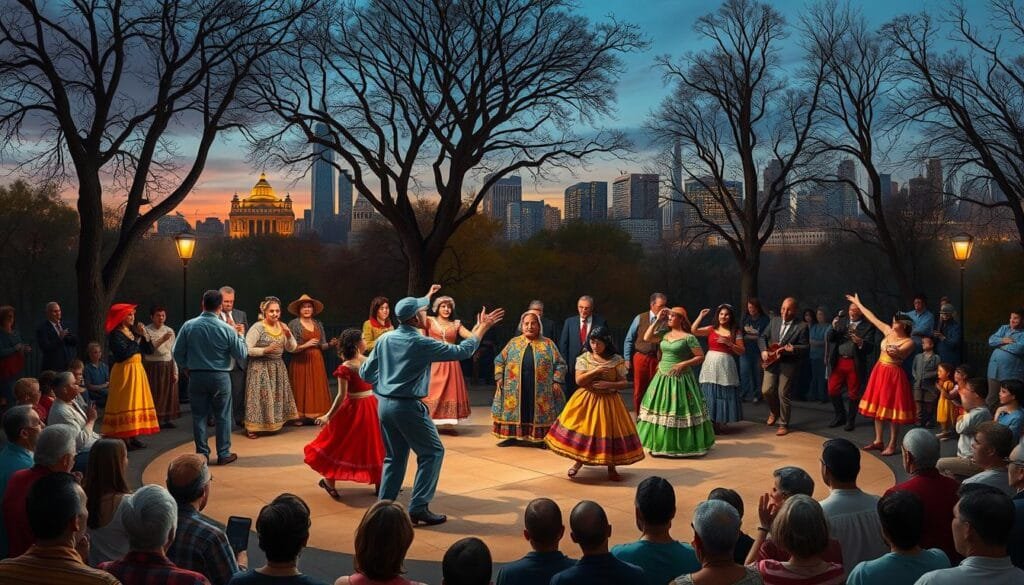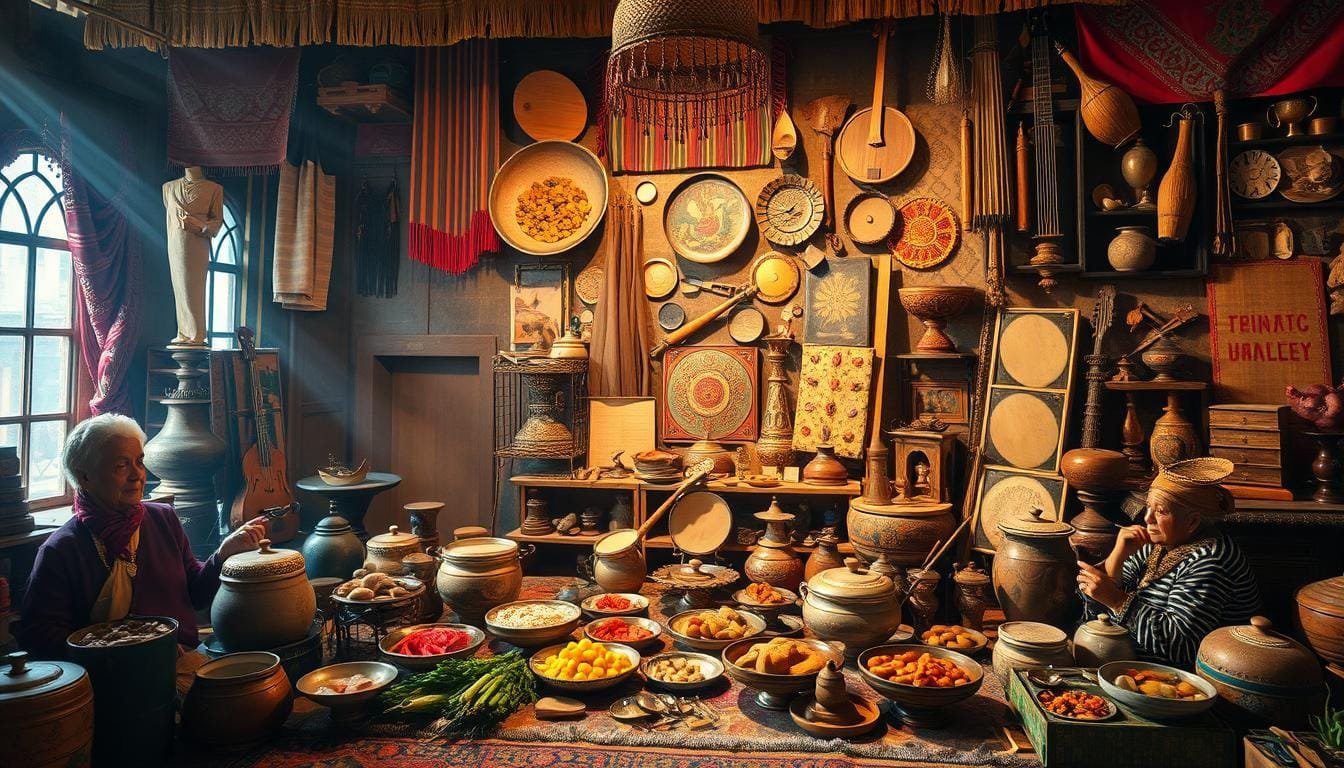How do immigrants keep their culture alive while blending into their new home? This puzzles sociologists and historians. Immigrants shape societies, especially in the United States. Despite tough economic times, they keep their traditions and enrich America’s culture.
Keeping their culture is tough but crucial for immigrants. This story shows how they hold onto their roots in a new place.
Key Takeaways
- Immigrants significantly impact America’s cultural and societal growth.
- Many succeed in keeping their heritage alive despite challenges.
- They add unique and varied elements to America’s cultural mix.
- Festivals, religious rituals, and celebrations keep immigrant cultures alive.
- Resilience and curiosity help immigrants preserve their culture.
- Musical blends like Dvorak’s New World Symphony show cultural mixing.
- Music history reveals a move from the sidelines to widespread acceptance.
Introduction to Immigrant Cultural Preservation
Immigrants often face the challenge of keeping their culture alive. They must balance fitting in with preserving their identity. It’s crucial to grasp the context of these efforts.
There are about 272 million migrants globally as of 2020, says the United Nations. The U.S. has around 430 different languages. This shows the vast mix of cultures trying to preserve their traditions in new places.
Keeping cultural roots while adapting to a new culture is a delicate dance. Schumann’s model shows how immigrants either blend in, maintain, adjust, or feel left out. Finding the right balance is key to keeping their identity.
Studies show that heritage language and culture might fade within two generations (Crawford, 1992; Krashen et al., 1998). Sometimes, speaking the native language at home isn’t enough to keep it alive. This can hurt family ties and make communication tough across different generations.
Reading and writing together early on is important, say Kondo (1998) and Cummins (2004). Kids with a strong grasp of their native language do better in the new community’s language. This highlights how a supportive home is crucial for keeping culture alive.
Mothers, more than fathers, are key in teaching language (Li, 2006). Grandparents also help by using the native language and being positive about it. This shows family’s big role in adapting to new cultures.
Friends can have a big impact on keeping a language too. Sometimes they influence more than parents do. This means social life outside the family is also vital for cultural identity.
Understanding the effort to preserve identity and blend cultures is important. It helps us see the complex and strong efforts to keep cultural identity while adjusting to a new place.
Role of Traditional Practices in Heritage Preservation
Traditional practices are key in keeping cultural heritage alive among immigrant communities. They help pass down unique customs through generations. This ensures culture, memory, and identity stay intact.
Religious and Spiritual Rituals
Religious rituals give immigrant groups strength and bring them closer. These practices link them to their ancestors and strengthen community bonds. For example, Asian American families maintain their heritage while adapting to new cultures. Korean families worship ancestors, keeping their beliefs strong across generations.
This is backed by research available here. It shows these practices pass down important family values. They emphasize respect for elders, a tradition that remains strong over time.
Cultural Festivities and Celebrations
Cultural events display the beauty of traditions. They build community and make culture active and visible.
For instance, Italian migrants stress passing down traditions, as discussed at the Diversity Matters Forum. Sir James Gobbo highlighted this, especially about first-generation migrants. The Korean Lunar New Year is a vivid example, connecting people to their roots.
Even with societal changes, immigrants blend these traditions with new norms. This builds a rich mix of old and new cultural practices.
Heritage events like the Gallipoli commemorations show the value of tradition. Turkey, Australia, and New Zealand work together here. They show how to honor shared history without losing its uniqueness.
These examples reveal how deep cultural beliefs grow stronger to maintain identity. To learn more about these processes, additional information can be found here.
How Did Immigrants Preserve Their Culture Simple Terms
Keeping their culture alive is crucial for immigrants. It helps them remember who they are in a new place. They use different cultural retention methods to keep connected to their roots. These practices start at home and grow into the community around them.

Teaching native languages to kids is a key method. It ensures these languages don’t disappear. Speaking their native tongue daily is at the core of immigrant adaptation strategies. It’s a big part of keeping their culture ongoing.
Food traditions also play a big role. Cooking and eating the dishes from their homeland keeps those traditions going. These meals bring families and communities together, especially during festivals and celebrations.
Being part of cultural groups is another way immigrants keep their culture. These groups offer a place to meet, share, and enjoy cultural activities together. They organize events and festivals that make everyone feel at home.
The media is also important. Listening to music, watching films, and reading books from their home countries provides comfort. These media pieces are a way to hold on to their cultural values and practices.
- Language Preservation: Teaching native languages keeps linguistic traditions alive.
- Culinary Traditions: Sharing cultural foods strengthens connections during celebrations.
- Cultural Organizations: Groups that offer support and celebrate heritage are vital.
- Media Use: Enjoying media from their countries keeps immigrants connected.
Immigrants have many strategies to keep their culture alive. These cultural retention methods and immigrant adaptation strategies are crucial. They protect cultural identities while facing the new life’s challenges.
| Statistic | Details |
|---|---|
| 20th Century Immigration | Approximately 15% of the U.S. population was foreign-born by the early 20th century |
| Age of Mass Migration | Around 30 million Europeans immigrated to the U.S. between 1850-1913 |
| Language and Naming Data | Analysis of 2 million records from 1920 and 1940 censuses |
| Immigrant Naming Adoption | After 20 years in the U.S., half of the gap in name choices between immigrant and native populations disappeared |
| Citizenship Status | More than two-thirds of immigrants had applied for citizenship by 1930 |
| Language Proficiency | Nearly all immigrants reported speaking some English by 1930 |
Contributions to American Culture
Immigrants have deeply enriched American culture. They’ve brought diverse influences across many sectors. From changing the performing arts to driving academic advancements, their role in the U.S. evolution is huge.
Influence on Performing Arts
Immigrants have made lasting marks on the performing arts in America. Legends like Al Jolson changed the music and entertainment world. They introduced new styles and performances filled with cultural richness.
Their contributions have made America’s performing arts scene both vibrant and inclusive. They’ve shared different rhythms, dances, and theatrical styles with everyone.

Scientific and Academic Advances
About 70 million immigrants have settled in the U.S. since 1820. They’ve brought new perspectives and expertise, fueling innovation and growth. Immigrants and their children, making up over a fifth of the U.S. population, have led to key advancements across various fields.
| Field | Immigrant Contributions | Impact |
|---|---|---|
| Performing Arts | Introduction of new music styles, dance forms, and theatre | Enriched American cultural diversity |
| Academic Advancements | Scientific research, technological innovations | Fostering national innovation and progress |
Cultural Assimilation and Identity
Cultural assimilation is a complex process. Immigrants often try to adapt to their new country while keeping their own culture. This journey of shaping their identity varies among different people and communities.
Factors like socioeconomic status, support networks, and personal goals affect how fast and well they assimilate. For example, many choose to settle in areas filled with people from their homeland rather than blending into the wider American society.
Forced assimilation has made some minority groups give up their identities, sometimes violently. Residential schools in the USA and Canada, which closed as recently as 1996, are harsh examples of this. They placed over 150,000 Indigenous children in such schools from 1883 to 1997 to force them to assimilate. 
Studies show that challenges in cultural integration have a big influence on identity. Immigrant kids in wealthier areas do better in school and feel happier. But those in poor areas don’t assimilate as well.
Kids with foreign names were seen to struggle more. They had higher unemployment rates, finished fewer years of school, and earned less than those with Western names.
Being bicultural leads to higher self-esteem. It also improves family ties and decreases anxiety and depression. This supports the idea of the “immigrant paradox,” as found in Seth Schwartz’s research. Holding onto one’s original culture while adapting to the new one seems best.
Understanding identity formation means looking at voluntary versus forced assimilation. Voluntary assimilation happens gradually as immigrants balance between cultures. It usually brings a stronger sense of belonging and a better life quality. But losing one’s original culture can cause sadness and stress, leading to mental health issues.
“Sociological analysis highlights the “model minority” myth, which portrays Asian Americans as a successful assimilation story. This view, however, overlooks the identity struggles and cultural integration challenges they face, which society often ignores.”
Considering these aspects shows that identity formation in immigrants is complex. It’s influenced by many factors and differs for everyone. While some immigrants mix well, others face big hurdles. This makes understanding cultural integration very important today.
| Aspect of Assimilation | Positive Outcomes | Negative Outcomes |
|---|---|---|
| Socioeconomic Status | Higher educational achievements in non-poverty areas | Negative impacts in poorer locations |
| Community Support | Improved family relationships via biculturalism | Isolation if support is lacking |
| Personal Aspirations | Enhanced sense of belonging | Psychological stress from unmet aspirations |
| Voluntary Assimilation | Higher quality of living | Potential loss of native identity |
| Forced Assimilation | Feeling safer in dominant culture | Anxiety, depression from identity dilution |
Case Studies: Cultural Preservation in Minnesota
In Minnesota, immigrant communities work hard to keep their cultures alive. Groups like the Swedes and Hmong have kept their traditions through many efforts. This shows their strong commitment and resilience.
Swedish Cultural Practices
The Swedish community in Minnesota takes big steps to maintain their heritage. Festivals, education, and cultural centers help keep Swedish traditions going. For example, the American Swedish Institute in Minneapolis teaches people about Swedish culture and history.
- Festivals: Swedish immigrants honor their heritage through events like Midsommar and Christmas.
- Educational Programs: Classes and workshops help people learn about Swedish culture.
- Cultural Institutions: Museums and centers store Swedish artifacts and history.
Hmong Cultural Contributions
The Hmong community in Minnesota also focuses on keeping its culture alive. They started arriving in the 1970s. By 2010, nearly all Hmong in the U.S. lived in the Twin Cities, showing its importance to their culture.
Education in the Hmong language and cultural arts is very important. Since 2000, over ten schools focusing on Hmong culture have opened. This helps young people learn about their heritage.
Cultural arts and festivals are key too. They allow the community to practice traditional ceremonies. Programs like the Hiawatha Valley Farm Cooperative also keep Hmong agricultural traditions alive.
Here’s a look at educational achievements within the Hmong community in Minnesota:
| Category | Percentage |
|---|---|
| High School Graduates | 76.2% |
| Bachelor’s Degree Holders | 13.7% |
| Graduate Degree Holders | 3% |
Making great efforts in education and culture helps Minnesota’s immigrants. Both the Swedish and Hmong groups preserve their rich heritage. This makes Minnesota’s society more diverse and colorful.
Conclusion
This exploration shows how vital it is for immigrant communities to keep their traditions, languages, and customs alive. Our findings reveal that immigrants enrich their new homes while keeping their unique identities. This is crucial for cultural preservation.
During the Age of Mass Migration, around 30 million Europeans came to the United States, facing many cultural challenges. By the early 20th century, immigrants made up about 15% of the U.S. population, a figure similar to today. They applied for U.S. citizenship and learned English, yet still celebrated their own traditions and beliefs.
More than two-thirds of immigrants had applied for citizenship by 1930. This shows their desire to belong in the U.S. but also to hold onto their roots.
Looking at immigrant history shows their skill in keeping their culture while fitting into American life. Stories from Minnesota highlight the Swedish and Hmong people’s impact. This shows America’s strength comes from cultural diversity.
The current wave of immigrants, even with their higher education and skills, continues to honor their heritage. This balance of keeping traditions and adapting to new ways shapes America. It proves the value of supporting and celebrating cultural diversity.
FAQ
What is cultural preservation among immigrant communities?
Cultural preservation is the effort to keep traditional practices, languages, and customs alive in a new country. It helps immigrants feel connected to their roots. This sense of identity and continuity is crucial.
How do religious and spiritual rituals support cultural preservation?
Religious and spiritual rituals connect immigrants to their history, providing strength and belonging. These practices maintain cultural heritage. They also strengthen the community’s identity.
What role do cultural festivities and celebrations play in heritage maintenance?
Cultural festivities showcase traditions and bring people together, strengthening group identity. These events are key for passing traditions to the next generation.
What are some common methods immigrants use to preserve their culture?
Immigrants keep their culture alive by teaching their children their native languages and keeping culinary traditions. They join cultural organizations and enjoy media from their homeland.
How have immigrants influenced American performing arts?
Immigrants have greatly enriched the American performing arts scene. Stars like Al Jolson introduced new styles that changed music and entertainment.
What impact have immigrants had on scientific and academic progress in the United States?
Immigrants have advanced science and academics in the U.S. by offering diverse views and knowledge. This promotes innovation and cultural appreciation.
What challenges do immigrants face during the cultural assimilation process?
During assimilation, immigrants struggle to balance adapting to a new culture while keeping their own. Socioeconomic status, support systems, and personal goals affect this balance.
How have Swedish immigrants in Minnesota preserved their cultural heritage?
Swedish immigrants in Minnesota preserve their heritage through festivals, educational programs, and cultural spaces. They celebrate their traditions and customs.
What are specific contributions of the Hmong community to cultural preservation in Minnesota?
The Hmong community in Minnesota keeps its traditions alive through language classes, cultural arts, and festivals. They ensure their heritage is passed down.
